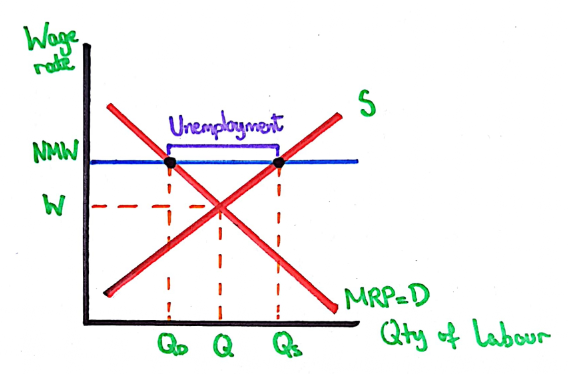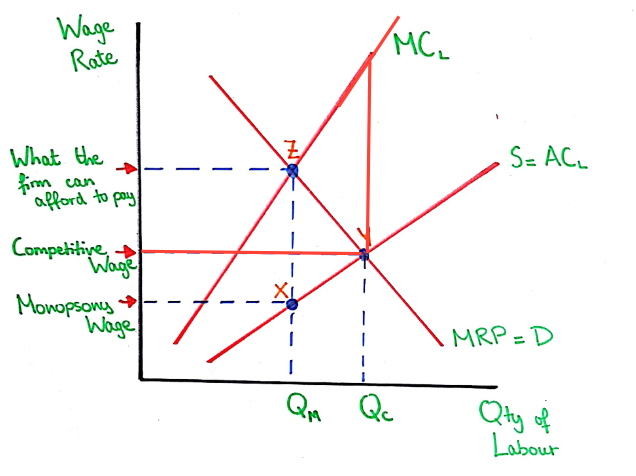Use the extracts and your knowledge of economics to evaluate the policies that government might use to reduce the gender pay gap.
Plan
- Intro
- Paragraph 1: a minimum wage
- Evaluation: a minimum wage is weak as it causes unemployment and this can widen the gender pay gap. but a minimum wage would work well if it is in a monopsony labour market.
- Paragraph 2: education and training. this boosts MRP which is one of the main factors causing lower demand for female workers.
- Evaluation: a good thing is that if this is visisble, it can also increase perceived MRP but if there is strong discrimination, then the government need to crack down on this instead.
- Conclusion: min wage in monopsony markets, but in general it is best to boost MRP through education and training.
The gender pay gap is an example of a wage differential. Wage differentials are when different workers earn different wages for different skills or working in different jobs. This may be an example of a market failure as there is a misallocation of resources, so the government may consider intervening.
One policy the government could use is to increase the mininum wage. This is a wage below which it is illegal to hire workers at, and it must be set above the equilibrium wage.

The diagram above shows the minimum wage successfully raising the wage from W to NMW, which could help to reduce the pay gap for the lowest paid workers. The issue with this policy is that it causes an excess supply of labour at the new wage and this would translate to unemployment in the real world. If some workers (women) are now unemployed, this increases the gender pay gap even more so this would be an ineffective policy, on its own at least. One idea would be for the government to implement a minimum wage only in monopsony labour markets.

A monopsony is a sole buyer of labour and the diagram above shows that they take advantage of their buying power by setting wage at the quantity where MC = MRP. Therefore the monopsony wage is very low, as shown. The government would be able to implement a minimum wage in this type of market and this leads to wages rising from the monopsony wage anywhere up to the competitive wage and the quantity of labour employed also rises from Qm to Qc. The reason for this is the extortionate profit firms were making when employing labour below their MRP. Even with a new legal minimum wage in place, firms would hire workers at the point where MC = MRP which is much higher now.
In evaluation to this, you could argue that this may be an unlikely policy as one of the main monopsony employers in the UK is the government, who employ teachers and nurses. The issue would be that this would increase the cost of the government and the opportunity cost of this is that the quality of other public services may get worse. The government do not make profit and any money saved on services such as schools may translate into other areas such as healthcare or police. Therefore, a minimum wage may be an ineffective policy overall.
Therefore, another policy to reduce the gender pay gap may be to focus on improving the education and training of women. In a free labour market, wages are determined by supply and demand of labour alone. So, if the demand for female workers is lower than the demand of male workers, then the best policies would focus on improving this. Demand for labour at any given wage is determined by three main factors, which are demand for the good itself (as labour is a derived demand), capital, and MRP. The main difference between two groups of workers would be MRP, marginal revenue product. This is how much extra revenue each unit of labour contributes to a firm. If women undergo education and training so there is no question that they have a different MRP to men, or improve it so that they have a higher MRP for men, then firms would increase their demand for female workers. The diagram below shows this.

Wages go up from W1 to W2 and quantity of female workers employed go up from Q to Q2 due to an increase in education and training causing an improvement in MRP causing greater demand for female workers.
I would evaluate the policy of increasing education and training and say that it would have a high opportunity cost as well, but also a large time lag. However, this is arguably worth it as it is more of a permanent solution to the gender pay gap issue rather than a quick fix (minimum wage). The only other issue is that there may be discrimination causing the gender pay gap and therefore no amount of education and training would help. If the government were to find this was the case, they should stamp down on regulation and laws preventing this. However, educating and training women may also increase the perceived skills and MRP of women so this may still help slightly.
In conclusion, I would encourage the government to implement national minimum wages that prevent monopsony markets from undercutting a worker from their MRP, whilst also investing in education and training programs for groups of people affected by pay gaps in order to increase their MRP. Trade unions would help in both scenarios as they would allow women to work together and collectively bargain for these higher wages and persuade the government to invest more into their training. An equal MRP between two groups of people is a long term solution to wage differentials.